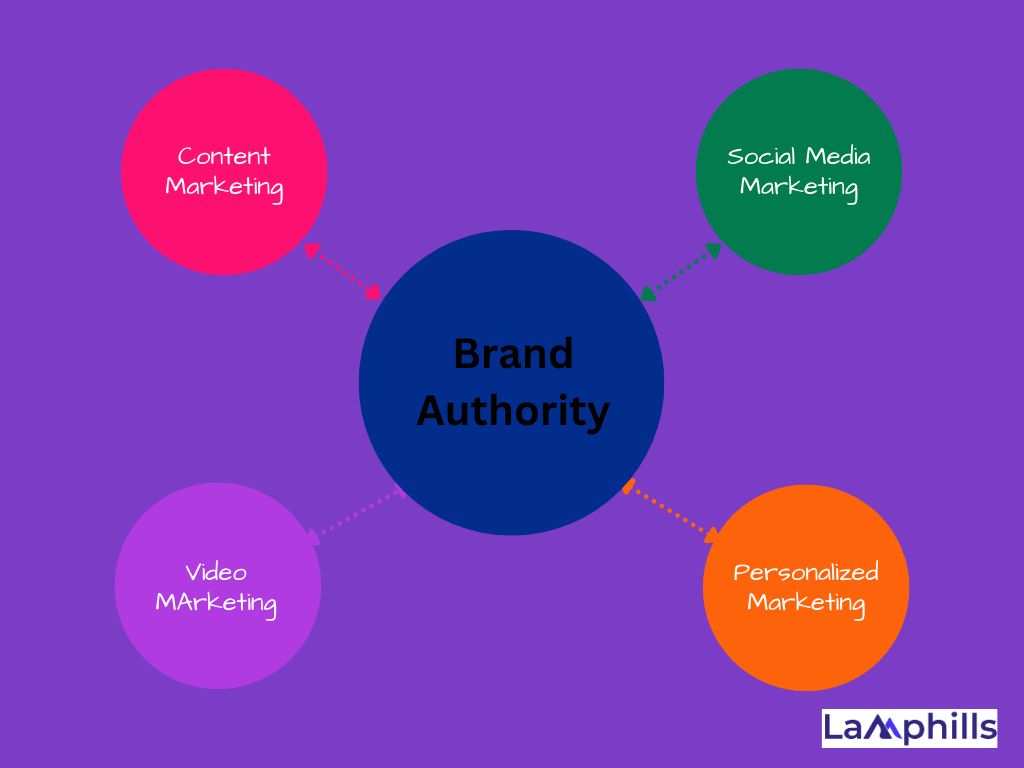As a young marketing intern, one of the challenges I faced was helping startups gain visibility in their field. I learned over time that brand authority matters much more than brand awareness, and I took the time to study some brands that have gained authority in their field and the strategies they implemented. I’ll share these strategies with you here, including metrics to help you measure your success. But first, let’s understand what brand authority is all about.
Key Takeaways
- Brand Authority determines how likely customers will see your brand as a trustworthy source of information or expet opinion in its field.
- The key components of brand authority are content marketing, video marketing, social media marketing and personalised marketing.
What is Brand Authority?
Brand authority refers to how likely customers will see your company as a trustworthy brand and source of information or expert opinion in its field. A company with a high level of brand authority might enjoy customer trust, a respectable reputation, and a high level of influence within its industry. For example, suppose a brand like Nike shares statistics about sports injuries online. In that case, customers may be more likely to trust that statistic than they might if published by another random company. This is because Nike has established a brand authority in its field. You can liken brand authority to online authority, which is customers’ trust in what a company posts on digital platforms. Brand authority goes beyond flashy logos or catchy slogans; it is about building a reputation based on trust, credibility, and influence. It’s about ensuring that your brand has a place on search engines You can measure your brand authority in various ways, which I’ll explain going forward.
How Brand Authority Drives Business Growth

Building a strong brand authority can accelerate and increase conversions for your business, amplifying the effects of your online marketing efforts. The more customers learn to trust your business, the more likely they will patronize it.
With a strong brand authority, prospective clients will be more likely to interact with and use your content when they see it. You can retain a loyal customer base that seeks you out first before turning to your competitors and attracting the attention of influencers within your industry, who can then use their authority to promote your brand. Now, there are key components that make a strong brand authority…
Key Components of Brand Authority

#1. Content Marketing
Every brand with established authority in its field has a thriving content marketing strategy. Take Apple, for example. Apple’s content marketing strategy includes creating high-quality, engaging content that resonates with its target audience. While providing value to its customers, Apple also regularly publishes educational and informative content through blog posts, videos, etc. Thus, Apple has established itself as a thought leader in the industry and has built trust with its customers.
#2. Social Media Marketing
What your brand says on social media matters; an unhappy customer can destroy what you have sweated to build with just one comment, and you’ll find yourself starting all over. That’s why social media marketing is an integral part of brand authority. With an effective social media marketing strategy, you can establish yourself as a trustworthy brand and cushion the effects of nasty comments.
#3. Video Marketing
With video marketing, you can create highly engaging content that captures your brand’s personality and proves your digital savvy using mobile-friendly content. You’re also showcasing your skills and the extent to which you’re willing to go to connect with your audience.
#4. Personalized Marketing
Personalized marketing shows customers that you genuinely care about them. You’ll gain their trust and loyalty as long as you’re transparent about why you want your customers’ information and ensure you always present content relevant to their interests.
These are the key components of brand authority. Any brand with established authority in its field will have all these components. Now, how do you effectively build brand authority in your field?
Strategies For Building Brand Authority
After studying some noteworthy brands like Apple and Nike and how they have gained authority in their field, I discovered the strategies that stood out for them, and I will share them with you below:
#1. Choose a niche
Decide on the niche you want to work with. Focusing on a specific niche will help you gain expertise in that niche quickly and stay up-to-date with the latest news and updates. It’ll even help if fewer companies offer expertise in that area; this can establish you as a leading expert in the industry. Take the time to research what your target audience likes and align your content to meet their needs while also promoting your product.
#2. Focus on Product Differentiation
People like to go for what’s different, that’s why Apple will always have a loyal customer base compared to the other tech companies. Strive to differentiate your products or services from competitors. Identify and highlight the unique features, design elements, or customer experiences that make set your offerings apart in all your content marketing efforts. Emphasize the value proposition and benefits customers can expect from choosing your brand.
#3. Tell a compelling brand story
Customer connection thrives on storytelling. The more the customers relate with your story, the more they trust your brand, and this will help build your brand authority. Create narratives that resonate with your target audience, demonstrating how your products or services can improve their lives or solve their problems. Your story should be compelling enough to evoke emotions within your audience.
#4. Create a Consistent Brand Identity
Develop a cohesive brand identity that reflects your company’s values, mission, and personality. Ensure that your visual elements, messaging, and customer interactions are consistent and align with your brand identity across all facets
#5. Leverage social proof
Encourage your customers to share their experiences with your brand through user-generated content. This can be in the form of product reviews, testimonials, social media posts, or videos. Showcase this content on your website and social media channels to build trust and authenticity within your audience.
#6. Invest in High-Quality Visual Content
Visual content is very powerful for capturing attention and telling your brand story. Invest in professional photography, videos, and graphic design to create visually appealing content that aligns with your brand identity. Use visuals to showcase your products, create engaging social media posts, and enhance the overall brand experience.
#7. Prioritize Customer Experience
Customer experience is key. This largely attributes to the success of many brands we’ve seen today. Prioritize delivering excellent customer service, personalized interactions, and seamless experiences across all touchpoints. Create and enforce a customer-centric culture within your organization.
Here’s a checklist for your reference:
Measuring Brand Authority: Metrics and Tools

I promised to give an insight on how to measure brand authority, and I’ll keep to my word. Here are some metrics you can utilize to measure your progress:
#1. Brand Mentions and Sentiment Analysis
Brand mentions are barometers of your brand’s visibility and relevance, while sentiment analysis depicts the emotions and perceptions underlying those mentions. I’ve witnessed the power of sentiment analysis in deciphering nuanced customer sentiments, enabling us to tailor our messaging and strategies accordingly.
#2. Social Media Engagement
Metrics such as likes, shares, comments, and retweets can give you an insight into audience engagement and brand affinity. Through firsthand experience, I’ve witnessed how a well-crafted social media strategy can transform passive followers into active brand advocates, propelling our brand to new heights of engagement and influence.
#3. Website Traffic and SEO Performance
Website traffic metrics show how many people are visiting your online domain, while SEO performance shows how relevant and visible your brand is on search engines. Throughout my career as a marketer, I have used SEO to push our brand to the top of search engine results pages, increasing our online presence and authority.
Tools and Techniques for Tracking Brand Authority
#1. Social Media Monitoring Tools
Social media monitoring tools such as Hootsuite, Sprout Social, or Mention can help you track brand mentions, sentiment, and engagement across various platforms. These tools offer real-time insights, empowering you to stay ahead of the curve and swiftly respond to emerging trends and conversations.
#2. Web Analytics Platforms
Web analytics platforms like Google Analytics or Adobe Analytics tend to provide granular insights into website traffic, user behavior, and conversion metrics, enabling you to fine-tune your digital strategy and optimize your brand’s online presence.
#3. Brand Monitoring and Reputation Management Tools
Brand monitoring and reputation management tools such as Brandwatch or Reputology offer comprehensive insights into brand sentiment, customer feedback, and online reviews, allowing you to proactively address issues and uphold your brand’s integrity.
Benchmarking Against Competitors and Industry Standards
#1. Competitive Analysis
Using competitive analysis tools such as SEMrush or Ahrefs, you can examine your competitors’ brand strategies. Compare your brand’s performance to that of competitors in the sector to find areas where it may stand out and innovate. By researching their approaches and methods, you can hone your own strategy and carve out a unique position in the market.
#2. Industry Benchmarks and Best Practices
Stay current with industry benchmarks and best practices through industry reports, conferences, and thought leadership publications. By benchmarking your brand’s performance against industry standards, you can identify areas for improvement and innovation. This will help you keep your brand at the forefront of industry trends and developments.
Challenges and Pitfalls In Building Brand Authority

Almost every brand would be at the forefront now if there were no challenges. I’ve identified the common challenges companies face when building brand authority and how to navigate them. Here are some of them:
#1. Negative Feedback and Reputation Management
As a brand strives to establish authority, it inevitably encounters criticism and negative feedback. It takes a level of competence to handle these situations, whether it’s a disappointed client complaining on social media or a negative review tarnishing your reputation. Negative feedback can undermine your brand’s credibility and erode trust among your audience.
#2. Maintaining Consistency
Maintaining consistency is such a difficult hill to climb, but once you’ve mastered the art of consistency, you will have dealt with almost all the challenges you will ever face. . Any deviation from your established brand persona risks diluting your authority and confusing your audience.
#3. Staying Relevant in a Dynamic Landscape
The world is constantly evolving, and so should your brand. Failure to adapt to the shifting consumer preferences, emerging technologies, and evolving market dynamics will result in your brand falling out of favor and losing its relevance in the market.
Read Also: What Does Evergreen Mean In Business? Timeless Tactics for Lasting Growth
So, how do you overcome these challenges and stay on track?
#1. Embrace Transparency and Authenticity
When faced with negative feedback, transparency and authenticity are your greatest allies. Address criticism openly, acknowledge mistakes, and demonstrate a genuine commitment to resolving issues. By showcasing your brand’s human side and willingness to learn and improve, you will attract more people and turn negative experiences into opportunities to strengthen trust and credibility.
#2. Develop a Comprehensive Brand Strategy
Consistency doesn’t happen by chance; it requires meticulous planning and execution. Develop a comprehensive brand strategy that outlines your brand’s identity, values, voice, and guidelines for maintaining consistency across all channels. Regularly review and refine your strategy to ensure alignment with evolving business objectives and market trends.
#3. Stay Agile and Adaptive
Agility is key to survival in a dynamic landscape. Stay up to date with industry trends, consumer insights, and competitive developments, and be prepared to pivot your strategies accordingly. Embrace innovation and experimentation, and don’t be afraid to take calculated risks to stay ahead of the curve.
Real-World Examples of Brands that Failed to Establish Brand Authority
#1. New Coke Debacle
In 1985, Coca-Cola introduced “New Coke” in an attempt to revitalize its brand and compete with rival Pepsi. However, the move backfired spectacularly, with consumers rejecting the new formula en masse. Despite extensive market research and promotional efforts, New Coke failed to resonate with consumers, highlighting the importance of staying true to your brand’s core identity and values.
#2. Pepsi’s Kendall Jenner Ad
In 2017, Pepsi faced widespread backlash for its “Live for Now Moments Anthem” commercial featuring Kendall Jenner. The ad, which depicted Jenner bridging the gap between protesters and police with a can of Pepsi, was criticized for trivializing social justice movements and exploiting activism for commercial gain. The controversy underscored the risks of misreading cultural sensitivities and attempting to capitalize on social issues without authenticity or sincerity.
How Do You Build Brand Authority Online?
Building brand authority online requires consistently delivering valuable content, authentically engaging with your audience, showcasing expertise, leveraging social proof, and fostering meaningful relationships with influencers and industry leaders. You can watch the video below for more insight:
What Is The Power Of A Brand?
The power of a brand lies in its ability to evoke emotions, build trust, and differentiate from competitors, influencing consumer perceptions and driving loyalty and purchasing decisions.
In Conclusion,
Brand authority is not just a goal—it’s a journey, a commitment to excellence, and a testament to your audience’s trust and confidence. Understanding the importance of authenticity, consistency, and credibility allows you to create a brand that resonates with consumers, inspires loyalty, and stands the test of time.
So, as you embark on your journey to build brand authority, ask yourself this: What story do you want to tell? And how can you leverage the power of brand authority to make that story a reality?
Related Articles
- Brand Advertising: Elevating Your Brand Awareness
- Corporate Communications: Strategies to Amplify Your Brand’s Message
- External Communication In Business: Strategies for Amplifying Your Business Voice






